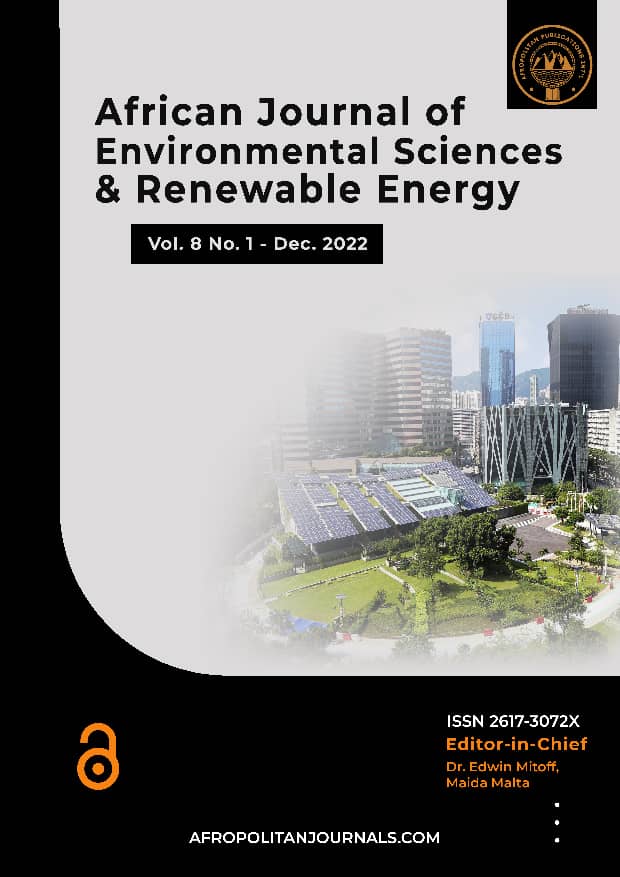Aquifer Characteristics of Some SelectedVillages around Kaduna Refining and Petrochemical Company (KRPC) in Chikun Local Government Area of Kaduna State, Nigeria
Main Article Content
Abstract
The Vertical Electrical Sounding (VES) technique was used to investigate the sub-surface layering in Unguwan-Barde, Rido village and kipi-nari kaukau, developing residential areas close to Kaduna Refining and Petrochemical Company (KRPC) in Chikun local government area of Kaduna State. 24 sounding stations were carried out aimed at evaluating the aquifer characteristics of the study area such as aquifer thickness. The result of the interpreted VES data suggests that the area is underlain by three to four layers and are inferred to be the topsoil, weathered basement, fractured basement and fresh basement. The resistivity values ranges from 80.7 Ωm. to 3063.5 Ωm. The resistivity values of the layers at the VES stations are characterized by H. K, Q, and HK resistivity curves with 14 of them having the HK, 6 with H curve type and 4 with Q curve type, The overburden thickness distribution map shows the southeastern region is 24.6 – 36.7 m (Rido village and Unguwan-barde) While the northwestern region is deeper 37.0 – 48.3 m (Kipi-nari kaukau).These suggest that the southeastern region have more potential for water than the northwestern region. The aquifer has an average resistivity of 346.2 Ωm, the weathered/fractured basement, which is the aquiferious formation has an average thickness of 25.1m. The thickness and resistivity of the aquiferious layers suggests that they are viable and they is good potential for water.
Downloads
Article Details

This work is licensed under a Creative Commons Attribution-NonCommercial-NoDerivatives 4.0 International License.
References
Abdullahi N. K. and Iheakanwa, A. (2013), Groundwater Detection in Basement Complex of Northern Nigeria using 2D Electrical Resistivity and Offset Wenner Technique’ International Journal of Science and Technology 2 (70), 529-531
Aboh H.O (2009), ‘Assessment of the Aquifiers in Some Selected Villages in Chikun Local Government Area, Kaduna State’, Science World Journal 4 (2) , 37-41
Aweto, K.E. (2012). Aquifer vulnerability assessment at Oke-Ila area, Southwestern Nigeria. International journal of physical sciences, 6(33): 7574 – 7583
Bashir, I. Y., Izham, M. Y., & Main, R. (2014). Vertical Electrical Sounding Investigation of Aquifer Composition and Its Potential to Yield Groundwater in Some Selected Towns in Bida Basin of North Central Nigeria. Journal of Geography and Geology, 6(1). https://doi.org/10.5539/jgg.v6n1p60
Dogara, M.D., Aboh, H.O., and Kogi, K.A., (2016a). Subsurface investigation for Groundwater at Ungwan Maji, Dan Hono Kaduna, Nigeria. Journal of the Nigeria Association of Mathematical Physics, 37: 199 – 204.
Dogara, M.D., Aboh, H.O., and Kogi, K.A., (2016b). D.C. resistivity investigation of subsurface layering for geotechnical application in Millenuim city, Kaduna, Kaduna State. Science World Journal, 11(2): 30 – 34
Omeje, M., Ebele, J. E and Ugwuoke, P. E (2015), Geophysical Analysis of Basement Terrain Groundwater using Vertical Eletrical Sounding: A case study of part of Abuja, North Central Nigeria. International Journal of Geophysics and Geochemistry, 92-97
Salako, A.O. and Adepelumi, A.A. (2018). Aquifer, Classification and Characterization. In: Muhammad, S.J. and Shaukat A.K. Aquifers; Matrix and Fluids. IntechOpen. DOI:10.5772/intechopen.69070
Sanjay, P. (2010). Deep Wells and Prudence: Towards Pragmatic Action for Addressing Groundwater Overexploitation in India. Published by World Bank, 1-19.
Tahir A.G., Garba, M.L. and Hanidu, I. (2015). ‘Hydrogeology and ground water quality of deep and shallow Boreholes in Kano Metropolis North Western Nigeria’, Journal of Environment and Earth Science, 5 (1), 100 – 166.

